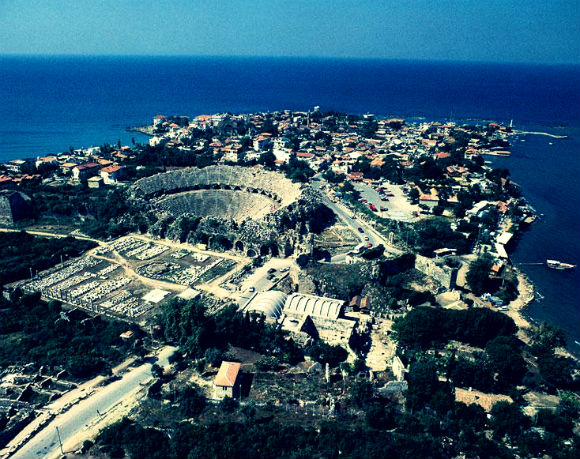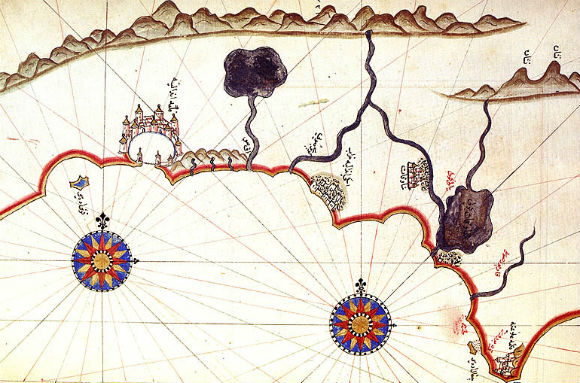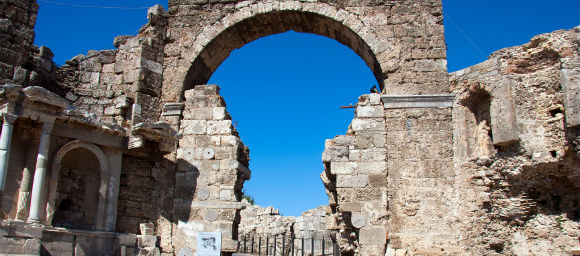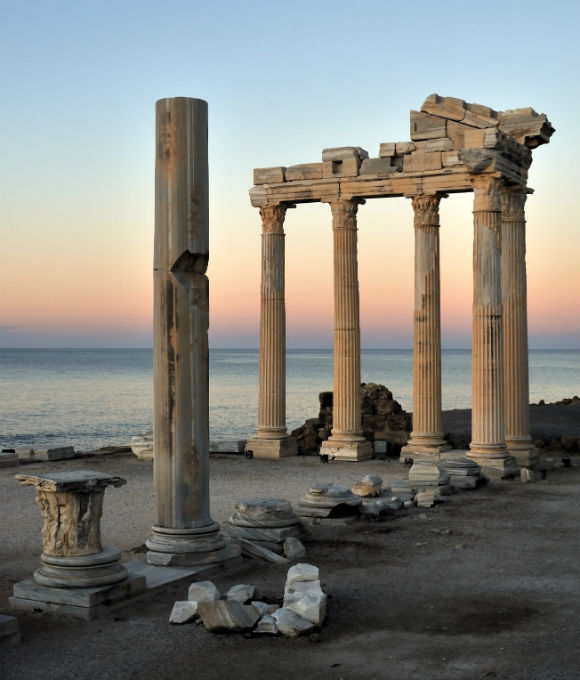Side (Greek: Σίδη is a city on the southern Mediterranean coast of Turkey, a resort town and one of the best-known classical sites in the country. It lies near Manavgat and the village of Selimiye, 75 km from Antalya) in the province of Antalya.
It is located on the eastern part of the Pamphylian coast, which lies about 20 km east of the mouth of the Eurymedon River. Today, as in antiquity, the ancient city is situated on a small north-south peninsula about 1 km long and 400 m across.
Upon opening to tourism in 1950s, the village of Selimiye was renamed Side, as the Roman city on the site of the village was known in ancient times. Today Side is one of the few sites where you can see Ephesus-like well-protected Roman ruins and modern constructions literally side by side.
Manavgat is your first point of entry if you plan to get to Side by bus. From Manavgat, some bus companies offer minibuses to Side from otogar (bus station) free of charge. There are also very frequent minibuses (dolmuş) from downtown Manavgat which should not cost much more than a couple of Turkish liras.If you want to go ftom Antalya you should get on Antalya-Manavgat bus at Antalya Otogar(Bus Terminal). Ticket is 10TL and get off at Side junction(Side Kavsagi). There is a free minibus service that takes people to a parking just beside the historical part of Side.

Side lies 2 km south of main highway (D400) of Mediterranean Turkey, so it’s also easy to get there by car.
You will find taxis everywhere. You are unlikely to have many problems with them, but always agree on a price beforehand. They can do it on the meter, but then they will only take you the long way round. Ask local shopkeepers/bar staff/hotel employees on how much a good price is so you’ve got a clue.
You can also get a dolmuş (literally means “squashed taxi”, just so you know what to expect!), a minibus service that runs along most main roads and past major hotels. If you are traveling far then you will probably have to change, but there should be a direct one to downtown Side. Charging around 3TL, this is the cheapest way to travel. They have stops, but you can ask the driver to stop anywhere on route usually. A cheap fun way of traveling, used by locals and tourists alike, just be prepared to travel in very crowded conditions.
History
Strabo and Arrian both record that Side was founded by Greek settlers from Cyme in Aeolis, a region of western Anatolia. This most likely occurred in the 7th century BC. Possessing a good harbour for small-craft boats, Side’s natural geography made it one of the most important places in Pamphylia and one of the most important trade centres in the region. According to Arrian, when settlers from Cyme came to Side, they could not understand the dialect. After a short while, the influence of this indigenous tongue was so great that the newcomers forgot their native Greek and started using the language of Side. Excavations have revealed several inscriptions written in this language. The inscriptions, dating from the 3rd and 2nd centuries BC, remain undeciphered, but testify that the local language was still in use several centuries after colonisation. Another object found in the excavations at Side, a basalt column base from the 7th century BC and attributable to the Neo-Hittites, provides further evidence of the site’s early history. The name Side is Anatolian in origin and means pomegranate.
Next to no information exists concerning Side under Lydian and Persian sovereignty.
Alexander the Great occupied Side without a struggle in 333 BC. Alexander left only a single garrison behind to occupy the city. This occupation, in turn, introduced the people of Side to Hellenistic culture, which flourished from the 4th to the 1st century BC. After Alexander’s death, Side fell under the control of one of Alexander’s generals, Ptolemy I Soter, who declared himself king of Egypt in 305 BC. The Ptolemaic dynasty controlled Side until it was captured by the Seleucid Empire in the 2nd century BC. Yet, despite these occupations, Side managed to preserve some autonomy, grew prosperous, and became an important cultural centre.
In 190 BC a fleet from the Greek island city-state of Rhodes, supported by Rome and Pergamum, defeated the Seleucid King Antiochus the Great’s fleet, which was under the command of the fugitive Carthaginian general Hannibal. The defeat of Hannibal and Antiochus the Great meant that Side freed itself from the overlord-ship of the Seleucid Empire. The Treaty of Apamea (188 BC) forced Antiochus to abandon all European territories and to cede all of Asia Minor north of the Taurus Mountains to Pergamum. However, the dominion of Pergamum only reached de facto as far as Perga, leaving Eastern Pamphylia in a state of uncertain freedom. This led Attalus II Philadelphus to construct a new harbour in the city of Attalia (the present Antalya), although Side already possessed an important harbour of its own. Between 188 and 36 BC Side minted its own money, tetradrachms showing Nike and a laurel wreath (the sign of victory).
In the 1st century BC, Side reached a peak when the Cilician pirates established their chief naval base and a centre for their slave-trade.
The consul Servilius Vatia defeated these brigands in 78 BC and later the Roman general Pompey in 67 BC, bringing Side under the control of Rome and beginning its second period of ascendancy, when it established and maintained a good working relationship with the Roman Empire.
Emperor Augustus reformed the state administration and placed Pamphylia and Side in the Roman province of Galatia in 25 BC, after the short reign of Amyntas of Galatia between 36 and 25 BC. Side began another prosperous period as a commercial centre in Asia Minor through its trade in olive oil. Its population grew to 60,000 inhabitants. This period would last well into the 3rd century AD. Side also established itself as a slave-trading centre in the Mediterranean. Its large commercial fleet engaged in acts of piracy, while wealthy merchants paid for such tributes as public works, monuments, and competitions as well as the games and gladiator fights. Most of the extant ruins at Side date from this period of prosperity.

One of the maps (portolani) of Piri Reis, taken from the Kitab-i Bahriye, which Piri produced in several editions, supplementing in 1520, but integrating it into subsequent editions.




Went to see a concert here by the Beijing Philharmonic Orchestra and was blown away by the acoustics and lighting effects.
We sat on the highest row which you were allowed to sit (top tear is not used) and could see everything perfectly and hear a pin drop it was so good.
They have festivals in this venue every September…
Went to the Temple first then back tracked to the ampitheatre – more people around at this time and site spread out more – very impressive and better looked after than the Temple – Would have liked to go in the dark as well to see the contrast between the two – Well worth the walk and some good shots…
They have constructed a large metal fence around the site, it is an eye sore. Not much to see and just not very nice
nice to see but there is not a lot of description. It would gain a lot if there was historical fact.
We actually went to a free classical concert there as it was arts festival week while we were there. Fantastic experience to see a concert in this theatre – really something to remember.
Can't believe this is as accessible as it is. Views are great and you can imagine the history from this place. You have the additional sea views too which just add to it. Side is a lovely place and a fantastic walk. Lots to see and do.
Worth to visit the place before/after sunset: you can take amazing photos not only about the temple but the neighboring stones (part of the ancient buildings) and the sea with its rocks as well.
Have a walk back to the taxi/dolmus in the busy main street of side in the evening, eat a real Turkish gyros or kebap or sit…
Been here far too many times ….. great opportunity for some great sunset photos from this location …. last time was there a few weeks ago end september 2013….. they have fenced the temple off from the public….. and look like they are doing work around it … im hoping this fencing is not permanent…… if staying in the area…
worth a visit small entrance fee, will be intersting to see how the renovation work progresses. Some signing in English but more would be useful
First time we visited Side the temple was unenclosed and free to scramble over. this year it has been fenced off & filthy lucre is required. Still a nice site looks best when viewed from out at sea